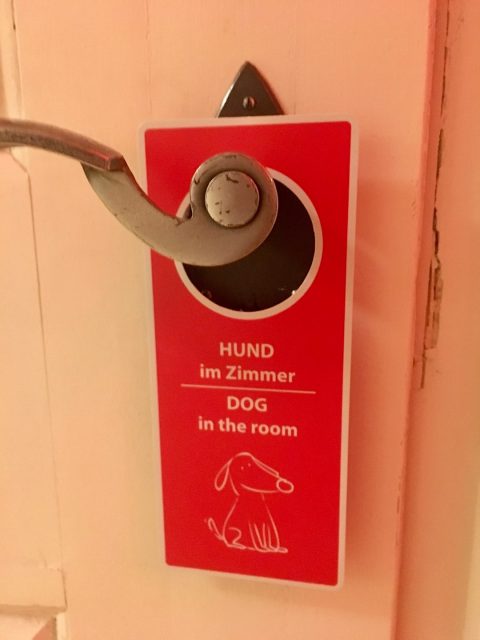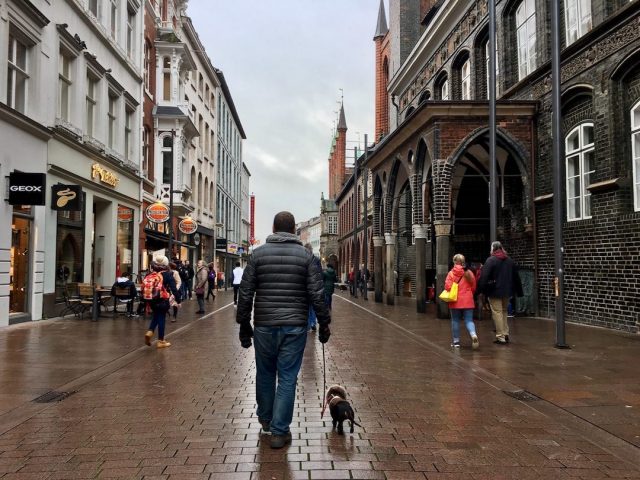No doubt about it, Germany is one of the most dog-friendly countries that I’ve visited, even amongst European countries. In Germany, dogs tend to be a normal part of society. It’s not uncommon for people to even take their dog along to work.
However, dogs are also held to high standards of behaviour in Germany, to make this possible. Taking your dog to behaviour classes is quite common.
So, if you’re heading to Germany, make sure your dog is similarly well-behaved, but know in advance that he’ll be welcome nearly everywhere. Here’s everything you need to know about visiting dog-friendly Germany with your dog.
Looking for more dog-friendly countries in Europe? Check out my list of the most dog-friendly countries

Travelling to Germany with a Dog
The standard EU rules apply to travelling to Germany with your dog. If you are travelling to Germany from another EU country or Switzerland, your dog will need to be microchipped, have an EU (or Swiss) pet passport and have been vaccinated for rabies at least 21 days before crossing the border. However, pet passports are generally not checked when crossing the border by car or train.
If you are flying to Germany from outside of the EU, as well as a microchip and valid rabies vaccine, your pet will require an EU health certificate (also known as the Annex IV) and in some cases a rabies titre test. Check out the full details on what’s required to travel to Europe with a dog.
Dining Out in Germany with a Dog
In Germany, most restaurants and cafes allow dogs, both inside and outside.
However, there are some exceptions. Many kebab shops (quite common in some cities) don’t allow dogs inside. I was also surprised when trying to have burgers for lunch in the western city of Trier, that both burger restaurants we visited didn’t allow dogs inside – a frustrating coincidence!
If in doubt, traditional brauhaus restaurants and small cafes are your best bet to dine inside with your dog during the cold winter months.

There’s also one unfortunate exception to this rule: the wonderful German bakeries found everywhere throughout the country. Bakeries in Germany are usually quite large, and often include cafe seating and excellent sandwiches for eat-in or take-away. They’re also usually the best spot to have a quick coffee or buy a to-go coffee.
However, dogs are nearly always not allowed, with a sign at the door translating as “I must remain outside”. The one exception is in train stations, where many bakeries are just a counter with no walls and doors – dogs are fine then at the tables.
Shopping in Germany with a Dog
Dogs are nearly always allowed in shopping malls in Germany, and many types of shops. Just always check at the entrance for any no dog signs. The main exception are grocery and other food stores, plus the bakeries as mentioned above.

Taking a Dog on Public Transport in Germany
No matter if you have a small dog or a large dog, I can’t think of any form of public transport in Germany where you can’t bring your dog along. As public transport reaches nearly every corner of Germany, this means it’s possible to travel easily around the country with a dog but without a car.
The main train operator in Germany is Deutsche Bahn. Click here to read the Deutsche Bahn pet policy (unfortunately and surprisingly, only in German). Here are the key points. On trains, small dogs and other animals (no larger than a domestic cat) in a container travel for free. For larger dogs, they require a child’s fare ticket, plus to wear a leash and muzzle.
Additionally, if buying the excellent value regional or Germany-wide weekday and weekend tickets, while children travel for free, dogs not travelling in a carrier are counted as an extra passenger. So if there’s two of you and a dog, you need to buy a ticket for three people. When writing the names of the passengers on the ticket, write “Hund” instead.
Sometimes on outings with our small dog, we didn’t take his carrier (as we didn’t want to carry it all day). In that case, we bought a ticket for him too, but based on the comments from a few ticket inspectors, we probably could have got away without paying for him.
When it comes to public transport, dogs are definitely fine to join you on local trains, metros, trams and buses. However, the pricing policy differs between the different cities.
In most cities, dogs not in a carrier require a reduced fare ticket. But in at least one or two of the cities I’ve visited, all dogs travelled for free.
In Berlin, dogs not in a carrier generally require a reduced fare ticket, such as if you buy a single ticket. But if you buy yourself a day ticket, one of the great benefits is that you can bring your dog along for free.

Dog-Friendly Accommodation in Germany
Most, but not all, hotels in Germany allow dogs to stay. (In my research into pet-friendly hotels in European cities, 70% of hotels in both Berlin and Munich allow pets.) Generally you’ll be charged a fee starting from around €10 per night.
There’s usually no issue taking them along to the restaurant or bar with you. Although most hotels I stayed at in Germany provide you with a door-hanger saying “dog in the room”, meaning you could have a dog-free meal as well. While leaving your dog alone in the room for the whole day would probably be frowned upon, generally there’s no rule stating you’re not allowed to leave them alone.

Some dog-friendly hotels around Germany that I recommend:
Note: This post contains affiliate links, which means I may receive commission if you make a purchase using the links. See my full disclaimer.
Vienna House Easy by Wyndham München (Munich)
A few kilometres from the centre of Munich, this 4-star hotel is modern and comes with amenities including a fitness room, sauna, free laundry room and restaurant. We stayed a week to recharge over the New Year period (and got in some workouts despite the snow falling outside!) I recommend asking for a room with a kitchenette (including a coffee machine).
Find out more and check the latest rates
25hours Hotel Bikini Berlin
This hotel was a bit pricey the weekend that we were staying in Berlin, but I’ve heard great things about multiple branches of this hip hotel chain, including that it warmly welcomes canine guests.
Find out more and check the latest rates
Hotel Theophano (Quedlinburg)
This historic town in the centre of Germany is a delight, with its streets of half-timbered houses, and a castle towering above. Hotel Theophano is located directly on the main square, in an historic building. The rooms are charming, yet renovated, and quite spacious. Double check what rooms pets are allowed in.
Find out more and check the latest rates

Mövenpick Hotel (Hamburg)
This unique hotel is situated in the middle of Schanzenpark, making it so easy to walk your dog morning or afternoon (or both!) That park is also popular with other local dog owners, so your dog will have plenty of opportunities for play.
Read more about the Mövenpick Hotel in Hamburg
What about Airbnbs you may ask? Due to legislation restricting the rental of entire apartments on Airbnb in many cities (to keep rental prices affordable for residents), whole house Airbnbs at an affordable price aren’t as common as in many other parts of Europe.
If you can’t up your budget, instead look at shared room options. Outside of the main cities, where this ruling doesn’t apply, you’ll also find more options.
Dog-Friendly Sightseeing in Germany
Germany offers up plenty of sightseeing opportunities where your dog can join you. Dogs are allowed in most outdoor spaces. This includes gardens surrounding palaces and castles, unlike is often the case in France.
Like most other countries though, the majority of churches, museums, and castles in Germany don’t allow dogs to accompany visitors inside. There are exceptions made at some small museums, generally with small dogs being allowed to be carried (in particular during the off-peak season). And there was one famous church in Germany we visited on a cold winters day that allowed us to carry our dog inside, although I won’t name which one!


These are my top recommendations…
1. Visit Sanssouci Park at Potsdam
A visit to Sanssouci Park at Potsdam, about an hour from central Berlin on the train, is an excellent day out from Berlin. The park include many fine palaces, once the principal residence of the Prussian royal family, and is often called the German Versaille.
While dogs aren’t allowed inside the palaces, they are allowed with you while you wander around the fine parks. Make sure you allow at least a few hours, but you could spend the entire day here.
Check out more photos from our visit to Sanssouci Park


2. Cruise Along the Rhine River
If you’re going to cruise along a stretch of the Rhine River, make it the section between St Goar and Bingen. As well as being home to the famous Lorelei Rock, there’s many historic castles, cute towns and terraces of vineyards lining the Rhine along this stretch.
We cruised with KD Cruises. Their cruises run regularly in summer, but there’s also the chance of a winter cruise if there’s enough bookings.
KD Cruises allows dogs on board, but no other animals. There is currently a small surcharge of €3.90 per dog, and they need to wear a leash and, if necessary, a muzzle. On the chilly day of our cruise, Schnitzel was happy to curl up in his bag most of the time.

3. Explore the Street Art of Berlin
Berlin is renowned for its street art. And while I haven’t yet met a dog interested in street art, they will enjoy walking with you through Germany’s streets while you spot new works and take photos.
One of the most popular spots is the historic East Side Gallery, where works are painted on a 1.3km long remnant of the Berlin Wall. The courtyard at the Anne Frank Zentrum is also fabulous.

4. Visit Neuschwanstein Castle
Neuschwanstein Castle in Bavaria is one of the most famous castle in the world, and well worth a visit. If you’re staying in Munich, it’s possible to visit the castle on a day visit, including the option of taking the train and bus. I’ve written a detailed guide on how to visit Neuschwanstein Castle on public transport.
Now, I must admit that dogs aren’t allowed inside the castle on the regular guided tours. But it’s still possible to visit the exterior of the castle with your dog, and go for a wander nearby. If you’re visiting with someone, it’s also possible to take turns taking a guided tour, with the tours starting and finishing very promptly!

5. Explore the Medieval Town of Quedlinburg
After visiting Germany multiple times, I have to award Quedlinburg the prize for being the most charming medieval town in the country I have visited so far. Its narrow streets are full of historic half-timbered houses that have survived through the ages. Plus above the town on a sandstone outcrop towers its castle and cathedral, both important to the history of Germany.
Naturally dogs are welcome to join you on your wanderings!

6. Visit Bergpark Wilhelmshöhe in Kassel
Located in the centre of Germany, the superb Bergpark Wilhelmshöhe features cascades, lakes and wooded slopes. It comes alive every Wednesday, Sunday and public holiday afternoon, between the months of May and early October, when the full water show is performed.
We visited both during a snowy day in winter, plus once again during summer when the water show was on. Entry is free year round and dogs are welcome.


7. Go for a Stroll in the Forest
Germany isn’t entirely about cities and industrial factories, there’s also plenty of natural landscapes that still stretch across the country, including plenty of forests. A walk for the forest is a great outing that your dog would love to join you on. Dogs are generally allowed either on leash or off leash depending on the area.
Head south to the famed Black Forest region or head just outside of Berlin to the Grunewald. We went hiking through the forest Hainich Forest in the centre of the country, a UNESCO-listed beech forest.

8. Visit the Gardens of the Würzburg Residence
The baroque Würzburg Residence palace has stunning interiors, that I highly recommend touring. And while the tours inside are strictly dog free (and with no photographs permitted), the exterior of the palace is surrounded by delightful gardens in the spring and summer months. Entry is free and dogs on a leash are permitted to join you.
If you wish to visit inside and are visiting with someone else, takes turns on the tours inside the palace like my husband and I did, while the other strolls around the garden or perhaps dines at the garden cafe, which naturally allows dogs.

9. Explore Historic Bremen
Bremen is a charming historic town located in the north of Germany. It’s easily visited on a day trip from Hamburg, or else stay one or two nights to fully explore it.
Don’t miss wandering through the Schnoor Quarter or the Böttscherstrasse, or getting a photo of the Bremen Town Musicians with your dog. Plus the House of History Museum (Bremer Geschichtenhaus) allows dogs inside!

10. Check out the Bauhaus Buildings in Dessau
If you love modern architecture, you can’t miss visiting Dessau (south of Berlin), home to the Bauhaus school during the 1920s. Highlights include the Bauhaus Building and the Masters’ Houses, but there’s also other works scattered throughout the town.
While dogs aren’t allowed inside, they can accompany you while viewing the exteriors. And dogs are allowed in the cafe at the Bauhaus Building (if you alternate taking turns visiting the interior).

11. Visit Lorsch Abbey
Located in between Heidelberg and Frankfurt, this historic monastery is best known for its “Kings Hall”, an unusual building from the Carolingian era that has survived to this day, despite the monastery being dismantled.
We took a guided tour of the Kings Hall, and our guide was fine with our small dog being carried along with us inside. The museum adjacent, with three collections covering the monastery, historic interior furnishings and tobacco, also allowed small well-behaved dogs to be carried inside. All dogs are also welcome to join their owners on the well-marked walk past the remains of the monastery.

12. Visit Wartburg Castle near Eisenach
Looking just like the classic idea of a castle, Wartburg is also fascinating for its famous residents, from St Elisabeth of Hungary to Martin Luther (after he was ex-communicated by the Catholic Church and was lying low).
Dogs are allowed in the interior courtyards, plus on the walking trails around the hilltop location. They aren’t allowed though on the guided tour inside or unfortunately inside the cafe. It’s best visited with you dog during the summer months. When we visited on a snowy winter’s day we choose to leave Schnitzel back at our apartment.

13. Visit a Christmas Market or Two
Germany is synonymous with Christmas markets, and if visiting any part of Germany in December, a Christmas market isn’t far away. They’re great for visiting along with your dog, as many of the locals do. Buy a warming glühwein, enjoy the wurst and other hearty streetfood, or browse for gifts and decorations.
Just a note: it’s best to avoid the more crowded ones (such as the main markets in Cologne and Heidelberg), at least during early evening, if you’re with a dog. Our favourite markets to visit with our dog were the quieter ones in smaller cities and towns.

You May Also Like
About the Author

Shandos Cleaver is the founder of Travelnuity: Dog-Friendly Travel. She has travelled extensively with her Miniature Dachshund, Schnitzel, including to 33 countries across Europe, every state and territory of Australia except Tasmania, and 10 of the United States. She’s passionate about providing inspiration and information to others wanting to travel with their dogs, whether close to home or internationally.
Inspired? Pin this to your Pinterest board!


Love your post! I’m seriously considering taking my shih tzu Francis to Germany with me for Christmas. I was thinking Nurnberg and Black Forest areas for a full Christmas experience (we live in Hawaii), for maybe 10 days or so (and for that reason am well aware and up to date on all entry/exit requirements for health certificates, etc!). It’s great to know taking the train or bus between locations will be a breeze, but was wondering if you had any insight into whether cities or smaller towns were more or less dog friendly? Would small dogs be permitted inside museums/castle tours if they were in a carrier? Did you make it to any ski lodges?
Sounds like an amazing trip Chrissy! In Germany, I’d probably say cities and towns were equally dog-friendly. Although in cities you’re more likely to see other people taking their dogs with them to restaurants and cafes. Unfortunately, usually small dogs even in a carrier aren’t allowed inside museums and castles. There are some exceptions, but nothing I know of in the Nurnberg and Black Forest areas. It’s always worthwhile asking, as we did get unofficial permission a few times – usually only if the museum is not busy and they can see your dog is well behaved. Neither my husband or I ski, so we didn’t look into ski lodges, but I’m sure there’s plenty of options. Also, I recommend the Christmas Market in Ulm – model trains, live animals in the manger, great food selections, and not as busy as some of the more popular markets like in Munich and Cologne (not ideal for dogs). Wishing you all the best!
Hey
Just wanted to add that I was recently allowed to carry my mini dachshund into the Lichtenstein Castle
Sarah – Thanks so much for sharing! The castle looks gorgeous, I would love to visit next time we’re in Germany.
Hi
Do you know if you could bring your dog to Germany for a holiday of say 1 month? Besides the rabies vaccination requirements, does the dog needs to get a dog license or insurance etc as would be required if the dog was going to live there permanently?
It’s fine to take your dog on a short holiday to Germany, there’s no requirements for a license, etc.
Hi I am so glad I found your blog! I will be travelling in September for about a month an a half around Europe and Berlin is a must stop for at least 4 days so this guide and pretty much all the info in your blog has been super helpful! I was just wondering about what you mentioned for the airbnb’s and hotels. I am travelling alone with my dog and I know there are many places where he can’t go in so I was mostly staying at airbnbs throughout my trip since in most countries you cannot leave a dog alone at a hotel room but that may not be the case in Berlin for what I understood, unless I got that wrong? So from your experience, could a dog probably be left alone at the hotel room for let’s say 4 hours? It’s been really hard to find a suitable airbnb so I just want to keep my options open and would really appreciate your insight.
I recommend asking one or two possible hotels for their policy. The hotel might be fine with it, particularly if you know your dog will be well-behaved and won’t bark. I generally found hotels in Europe didn’t have that many pet rules (or at least give you a copy), compared to hotels in the UK and USA.
Thank you for your posts… i am low butget traveller since 10 years, and now i have a dog. And i am so nervous about traveling with him, you help me so much!
Germany is a great place to travel with a dog, wishing you a great time together!
Hi! Great article. I’m bringing my dog from overseas to Spain, but because he’s large I need to fly into Germany (Frankfurt or Berlin) then get from there back home to Barcelona. I have no idea if I can take him on a train from Germany to Spain, nor where to even look for this info (it’s how I found your article!). Any suggestions gestiona/ideas?
He’s a 7yr old 30kg well behaved German Shepherd.
Large dogs are find on the trains in Germany and France, but Spain has generally prohibited large dogs (over 10kg) on long distance trains. I recently heard about a trial to allow large dogs, firstly on trains from Barcelona to Madrid: https://www.facebook.com/pipperontour/posts/pfbid04zdCbqxStcb7jTC1sYpCYEAEeVJQPzpWconrax2ebDLvfTB2aJiQ96TDNdL6eE6Cl. Perhaps look into whether this would be useful? Otherwise I recommend hiring a car in Spain or looking on Blablacar.
99% bakeries, grocery stores or cafe has stop-sign for dogs. unfortunately very hostile country for dogs, unlike Italy :((
When visiting Germany, we found most cafes allowed dogs, with no signs prohibiting them. Unfortunately, the great bakeries in Germany are off limits (including if you’re buying takeaway coffee!), but I’ve also seen no dog signs in some bakeries in Italy, and this is usually also the case in France (although sometimes locals ignore the signs). Across Europe, I’ve only come across some grocery stores in Italy that allow dogs – it’s quite a unique situation, and the German one is more typical.
I was hoping to be able to take my lab with me, but she might be too big of a breed to take into the restraints, and most of my trip includes visiting museums and cathedrals. I doubt she’d do well alone in a hotel all day lol
Larger dogs are usually accepted throughout Germany in restaurants (partially as most dogs in Germany are expected to be well trained from a young age). But yes, museums and cathedrals are an issue with any size dog.